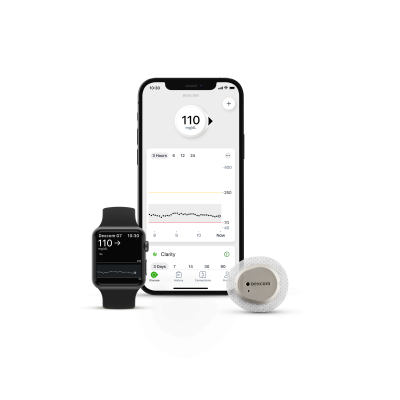Dexcom is in seventh heaven: A year after its initial FDA submission, the diabetes tech maker has finally gotten the green light to begin rolling out its latest continuous glucose monitor system in the U.S.
The G7 sensor was cleared for use by people ages 2 and older with either Type 1 or Type 2 diabetes, Dexcom announced Thursday. The stateside rollout will begin “in the coming months,” CEO Kevin Sayer said in the announcement.
Alongside that launch, while still awaiting a final Medicare reimbursement decision, Dexcom said it will offer “accessible cash pay options” to make the CGM immediately available to as many users as possible.

The G7 sensor adheres to the back of the upper arm or, if pediatric patients prefer, the upper buttocks. After a 30-minute warmup period, the sensor can begin automatically sending glucose readings every five minutes to a connected smartphone or Dexcom receiver. Each of the devices can be worn for up to 10 days, though the G7 edition offers an additional 12-hour grace period for sensor replacement.
The new CGM system improves upon its predecessor both physically and in terms of its glucose-tracking abilities. Like the G6, it eliminates the need for regular fingersticks to calibrate the device, wirelessly connects to digital health apps installed on wearables from Apple, Garmin and more, and allows users to share their data in real time with up to 10 family members, friends or caregivers.
The G7 sensor, however, is 60% smaller than the G6, thanks to a longstanding collaboration with Alphabet's Verily to miniaturize CGM technology. It also includes fewer components and integrates with a redesigned mobile app, both of which are meant to make the system easier to use, and it updates the previous system’s alert settings, allowing for more discreet alarms if a user’s glucose leaves its predetermined healthy range or is at risk of dropping below that range—the latter of which can be calculated 20 minutes in advance by the system’s predictive algorithms.
Dexcom’s latest CGM also boasts the company’s most promising accuracy levels yet. In study results presented earlier this year, the G7 sensor achieved a mean absolute relative difference, or MARD, of 8.1% in children and 8.2% in adults, denoting the average variation between the device’s readings and a user’s actual blood sugar levels, as confirmed by a fingerstick.
A glucose monitor with a MARD level below 10% is considered to be highly accurate; earlier this year, Abbott became the first to cross the 8% threshold when it reported an average variation of 7.9% in a study of its 14-day FreeStyle Libre 3 sensor, which had previously registered MARD levels closer to 9% in the data Abbott submitted (PDF) for the CGM's FDA clearance.
The FDA’s nod for the G7 system comes several months after Dexcom secured CE mark clearance and began rolling out the sensor across Europe.
The company originally applied for FDA clearance in the fourth quarter of 2021, but, in July, Sayer reported that Dexcom was in the process of resubmitting the filing based on questions the FDA had raised about the G7 software’s alarms while reviewing the application.
Dexcom completed those updates within a few months, prompting Sayer to suggest during a late October investor call that FDA clearance would arrive before the end of the year—a “very confident” prediction that has now been proven true.